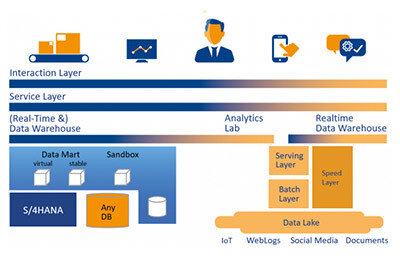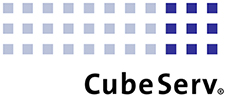The development of an end-to-end data platform is an essential building block for successfully shaping the digital transformation.
Previously published:
- Part 1: How to make business analytics successful?
- Part 2: Business Analytics vs. Business Intelligence
- Part 3: What is SAP Analytics? The SAP Data Warehouse Portfolio
- Part 4: SAP Analytics – The Front End Products
- This is part 5:
Data Corporation ( IDC ) found in a study that analytic projects aimed at improving operations had an average ROI of 277 percent; those affecting financial management – 139 percent; and those focused on customer relationship management – 55 percent.
For change, we need credible role models
Why do you think the enormous potential is not being leveraged? I often hear three explanations: First and foremost, I perceive that customers see analytical competence as something you can buy. In my eyes, this is the biggest misunderstanding: Good fact-based decisions cannot be outsourced. You have to get your fingers dirty and understand the context. This is the only way to keep the ship on course, even in the face of headwinds. It requires a mindset to make fact-based decisions successfully and quickly. In my view, mindset is an essential part of leadership. I have worked in consulting for 20 years with some very successful managers. One thing these successful people always had in common was that they got to the bottom of things themselves. With this own reference, they made their decisions with great certainty. Not only did they have to rely blindly on their employees, but they were able to understand their recommendations and thus stand fully behind the path they found.Silos limit the view of opportunities and challenges
The second reason often cited is that users see many analytical solutions as silos. Because a common view of the various data in the company is missing, potential for new services and leaner processes is wasted. Certain data and correlations can be analyzed here. For the user, neighboring domains are missing and cannot be supplemented by simple means. Here, the well-known reference in the Excel – Warehouse is rampant. We all know endless meetings in which uniform definitions are fruitlessly argued over. The construction of the various enterprise data warehouses was costly, not least because of such coordination processes. The technology gives you direct access to the source data. This clarifies data sovereignty, and we have unambiguous data definitions. Today, it is easy to look at processes with the same eye. This is the prerequisite for interdisciplinary teams to work together efficiently. Where there is value, the efforts to build the core data platform are worthwhile. Highly motivated teams from different parts of the business speak the same language and understand the relationships through appropriate data models. Appropriate documentation helps identify relationships. High quality data as well as metadata justifies trust in the solution. I like to refer to the core data platform as the factory mode. It is typical that the structure setup is a bit more complex, but the solution operation is stable and efficient. I’m thinking here of solutions for year-end closing, monthly reporting, and so on. Central solutions are not the right place to try something out quickly or to freeze the data stock for a certain time. Preparing data differently for exactly one use case usually takes two – three weeks, during which each update of the data destroys the interim result. Some hypothesis need this time. In addition to the central factory, there needs to be an addition of a sandbox (which is often referred to as a laboratory in analogy to the factory). We all know that the world can hardly be divided into black and white. Certain requirements are subject to constant change. Let’s just think of our colleagues in marketing. The ink under the concepts is usually not even dry when the first changes are already emerging. And in truth, this is not due to the inability and ill will of those involved, but rather the requirements are constantly changing, and good employees always have new ideas. Not every idea delivers what it promises at the beginning, but nobody knows in advance which idea will be the one that will bring the breakthrough. These are productive applications whose constant adaptation is a constant side effect. I like to talk about the workshop mode of an application. In order to run such an application well and efficiently, it is definitely worthwhile to build on stable structures from the basic model. It is just as important to build on this with flexible structures without introducing unrest into the basic structure. A modern data platform is characterized by the fact that these three important operating modes – laboratory, workshop and factory – are possible. In addition to the added value provided by integrated functions and data typical of SAP systems, users need touchdown points to implement their creative ideas with the tools of their choice.
Tom Davenport has developed and presented the DELTA model. A successful transformation to an analytical competitor starts at different points. The journey to success is complex, starts with simple steps.
Start small: Start with the data platform you build out for the different use cases
Rome wasn’t built in a day. In my eyes, this is true for a good data platform. I took the concept of “dessert first” from agile software development. Delivering the greatest business benefit first – that creates confidence and enthusiasm. Many IT projects lack this. Putting yourself in the shoes of your users right at the beginning and looking at the project through the eyes of the users helps to taste the “dessert” right away. Anyone who sees small children in the kitchen just before noon knows what I am talking about. And the shining eyes are then reward for the good cook :). In addition to the tangible customer benefit, it is important for me to establish the right framework. That means linking the different databases together to build a data platform, running it with the necessary and appropriate governance and offering the right toolset to the users. These basics (the agile mindset and the necessary experience) grow with the company and guarantee successful decisions.
What Jeff Bezos, the founder of Amazon, reported fits in with this: “Our success at Amazon is a function of how many experiments we do per year, per month, per week, per day… We’ve tried to reduce the cost of doing experiments so that we can do more of them. If you can increase the number of experiments you try from a hundred to a thousand, you dramatically increase the number of innovations you produce.”
SAP delivers its products on the Business Technology Platform – we also need a platform for end-to-end analytics scenarios

